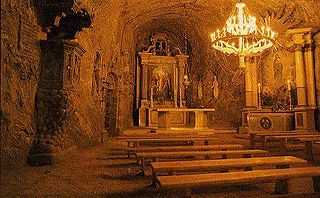Bochnia Salt Mine

The Bochnia Salt Mine (Polish: kopalnia soli w Bochni) in Bochnia, Poland is one of the oldest salt mines in the world and the oldest one in Poland.[1] The mine was established between the 12th and 13th centuries after salt was first discovered in Bochnia, and became part of the Royal mining company żupy krakowskie (Kraków salt works).
The mine was closed some time after World War I. In 1981 it was declared a heritage monument. The site is one of the Polish National Historic Monuments (Pomnik historii), as designated October 6, 2000, and tracked by the National Heritage Board of Poland.
History
The mine shafts measure 4.5 kilometres (2.8 mi) in length at about 330–468 metres in depth below the surface, at 16 different levels. The August Passage is the main communication and transportation route in the mine. It runs from the east to the west of mine, connecting in a stright line the bottom ends of the Campi and Sutoris shafts. It is situated at a depth of 176m - from the top of the Sutoris shaft and the depth of 212m counting from the top of the Campi shaft. The August Passage was initially called the Long Stove (Piec Długi). Its first part, extending between the Rabsztyn Chute and a Campi Shaft was built in the years 1723-1743, in accordance with a design by Jan Gottfried borlach. His great achievements was to regulate routes in the mine by ensuring their straightening and leveling. As a result of this, over the nest decades, the August Passage was able to reach a length of nearly 3-km. Excavated chambers, shafts and passages form an underground town, which is now open to sightseers. The largest of the preserved chambers has been converted into a sanatorium.
The Ważyn Chamber was named after the name of the administrator (podżupek) Andrzej Ważyński. The deepness of this chamber, the biggest in Bochnia Salt Mine, is 248m, its length - 255m, its maximum width 14,4m and maximum height 7,2m. The chamber uses no supporting pillars. Salt from Ważyn chamber was extracted from 1697 until the 1950s. For the purposes of creating a sanatorium these old pits were expanded with the LHD unit machine (a loading-hauling-dumping machine). These works took place until 1984, and thanks to them the Ernest Chute from the 17th century so impressively presents itself on the stripped chamber's roof. The Ważyn chamber has a specific microclimate, with a constant temperature between 14–16 °C (57–61 °F), high humidity (about 70%) and favourable ionisation of the air - saturated, at the same time, by sodium chloride and valuable microelements, like: magnesium, manganese and calcium. The air in the chamber destinguishes itself by its purity. The chamber is equipped with beds, up to 300 people can sleep in here. The other parts of Ważyn Chamber are: fields for playing volleyball, basketball and handball, restaurant and conference facilities.
In 2013 the mine was added to the UNESCO World Heritage List as an extension of the Wieliczka Salt Mine inscription of 1978.[1]
See also
| Wikimedia Commons has media related to Bochnia Salt Mine. |
- Wieliczka Salt Mine, near Kraków in Poland, central Europe
- Kartchner Caverns State Park in Arizona, the United States
- Grand Roc in Savoie, France, southern Europe
- Salt Cathedral of Zipaquirá, in Zipaquirá, Cundinamarca, Colombia, South America
- Chełm Chalk Tunnels, Poland, central Europe
- Frasassi Caves, Ancona in Italy, southern Europe
References
- ↑ 1.0 1.1 Wieliczka and Bochnia Royal Salt Mines (extension to the Wieliczka Salt Mine). UNESCO World Heritage Centre, 03/07/2013.
Coordinates: 49°58′09″N 20°25′03″E / 49.96917°N 20.41750°E
| |||||